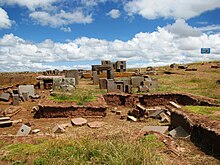Pumapunku

View at Pumapunku
|
|
| Alternate name | Puma Punku |
|---|---|
| Type | Part of a large temple complex |
| Part of | Tiwanaku Site |
| Length | 116.7 metres |
| Width | 167.36 metres |
| History | |
| Material | Earth, blocks |
| Founded | 536–600 |
| Cultures | Tiwanaku empire |
| Site notes | |
| Excavation dates | Vranich |
Coordinates: 16°33′42″S 68°40′48″W / 16.56169°S 68.679931°W
Pumapunku or Puma Punku (Aymara and Quechua puma cougar, puma, punku door, Hispanicized Puma Puncu) is part of a large temple complex or monument group that is part of the Tiwanaku Site near Tiwanaku, in western Bolivia. It is believed to date to AD 536 and later.
Tiwanaku is significant in Inca traditions because it is believed to be the site where the world was created. In Aymara, Puma Punku's name means "The Door of the Puma". The Pumapunku complex consists of an unwalled western court, a central unwalled esplanade, a terraced platform mound that is faced with stone, and a walled eastern court.
The Pumapunku is a terraced earthen mound that is faced with blocks. It is 167.36 metres (549.1 feet) wide along its north–south axis and 116.7 metres (383 feet) long along its east–west axis. On the northeast and southeast corners of the Pumapunku, it has 20-metre (66-foot) wide projections that extend 27.6 metres (91 feet) north and south from the rectangular mound.
The eastern edge of the Pumapunku is occupied by what is called the Plataforma Lítica.. This structure consists of a stone terrace that is 6.75 by 38.72 metres (22.1 by 127.0 feet) in dimension. This terrace is paved with multiple enormous stone blocks. It contains the largest stone slab found in both the Pumapunku and Tiwanaku Site, measuring 7.81 metres (25.6 feet) long, 5.17 metres (17.0 feet) wide and averages 1.07 m (3 ft 6 in) thick. Based upon the specific gravity of the red sandstone from which it was carved, this stone slab has been estimated to weigh 131 metric tons.
...
Wikipedia
